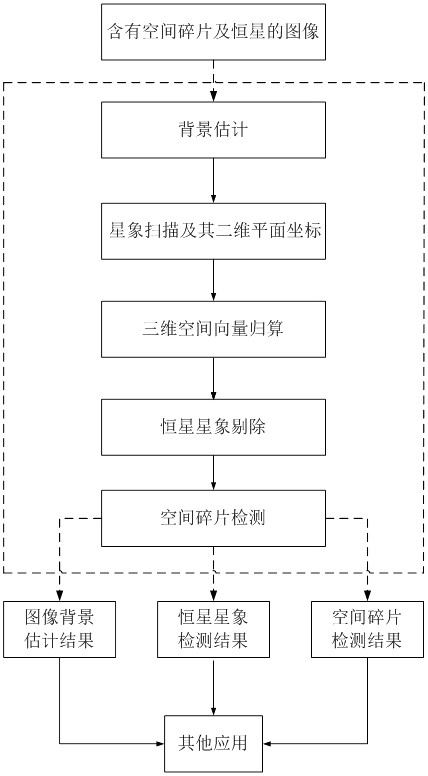A Space Debris Detection Method Based on Inertial Space
A space debris and inertial space technology, applied in photo interpretation, climate sustainability, ICT adaptation, etc., can solve problems such as increasing the probability of false alarms and affecting the success rate of detection, reducing false alarms and improving the success rate of detection. Effect
- Summary
- Abstract
- Description
- Claims
- Application Information
AI Technical Summary
Problems solved by technology
Method used
Image
Examples
Embodiment Construction
[0037] The present invention will now be described in further detail with reference to the accompanying drawings.
[0038] like figure 1 A space debris detection method based on inertial space is shown, which includes the following working steps: image background estimation; star scan and two-dimensional plane coordinate reduction; three-dimensional space vector reduction; background star removal; space debris detection.
[0039] Input the image of the multi-frame transfer CCD, and follow the above five steps in sequence. Finally, the detection result of the moving target in the image is obtained, which is provided to the servo system in the measurement system, so as to realize the tracking of space debris by the measurement system. A more optimized and more specific description of the above steps is as follows:
[0040] 1. Image Background Estimation
[0041] Comprehensive analysis of images containing space debris and background stars is carried out, and a mathematical mod...
PUM
 Login to View More
Login to View More Abstract
Description
Claims
Application Information
 Login to View More
Login to View More - R&D
- Intellectual Property
- Life Sciences
- Materials
- Tech Scout
- Unparalleled Data Quality
- Higher Quality Content
- 60% Fewer Hallucinations
Browse by: Latest US Patents, China's latest patents, Technical Efficacy Thesaurus, Application Domain, Technology Topic, Popular Technical Reports.
© 2025 PatSnap. All rights reserved.Legal|Privacy policy|Modern Slavery Act Transparency Statement|Sitemap|About US| Contact US: help@patsnap.com



